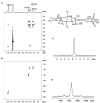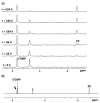New Oxaliplatin-Pyrophosphato Analogs with Improved In Vitro Cytotoxicity
- PMID: 34200051
- PMCID: PMC8200237
- DOI: 10.3390/molecules26113417
New Oxaliplatin-Pyrophosphato Analogs with Improved In Vitro Cytotoxicity
Abstract
Two new Pt(II)-pyrophosphato complexes containing the carrier ligands cis-1,3-diaminocyclohexane (cis-1,3-DACH) and trans-1,2-diamine-4-cyclohexene (1,2-DACHEX), variants of the 1R,2R-diaminocyclohexane ligand present in the clinically used Pt-drug oxaliplatin, have been synthesized with the aim of developing new potential antitumor drugs with high bone tropism. The complexes are more stable at physiological pH than in acid conditions, with Na2[Pt(pyrophosphato)(cis-1,3-DACH)] (1) slightly more stable than [Pt(dihydrogenpyrophosphato)(1,2-DACHEX)] (2). The greater reactivity at acidic pH ensures a greater efficacy at the tumor site. Preliminary NMR studies indicate that 1 and 2 react slowly with 5'-GMP (used as a model of nucleic acids), releasing the pyrophosphate ligand and affording the bis 5'-GMP adduct. In vitro cytotoxicity assays performed against a panel of four human cancer cell lines have shown that both compounds are more active than oxaliplatin. Flow cytometry studies on HCT116 cells showed that the pyrophosphato compounds with the non-classical 1,3- and 1,4-diaminocyclohexane ligands (1 and 4) are the most capable to induce cells' death by apoptosis and necrosis.
Keywords: antitumor drugs; bone tumors; cisplatin; oxaliplatin; phosphaplatins; pyrophosphate.
Conflict of interest statement
The authors declare no conflict of interest.
Figures














Similar articles
-
Effect of chirality on the anticancer activity of Pt(II) and Pt(IV) complexes containing 1R,2R and 1S,2S enantiomers of the trans-1,2-diamino-4-cyclohexene ligand (DACHEX), an analogue of diaminocyclohexane used in oxaliplatin.Dalton Trans. 2021 Nov 9;50(43):15655-15668. doi: 10.1039/d1dt02255e. Dalton Trans. 2021. PMID: 34673864
-
Platinum(IV) Complexes of trans-1,2-diamino-4-cyclohexene: Prodrugs Affording an Oxaliplatin Analogue that Overcomes Cancer Resistance.Int J Mol Sci. 2020 Mar 27;21(7):2325. doi: 10.3390/ijms21072325. Int J Mol Sci. 2020. PMID: 32230896 Free PMC article.
-
Synthesis, structural characterization, and antitumor properties of a novel class of large-ring platinum(II) chelate complexes incorporating the cis-1,4-diaminocyclohexane ligand in a unique locked boat conformation.J Med Chem. 1994 Aug 19;37(17):2630-6. doi: 10.1021/jm00043a003. J Med Chem. 1994. PMID: 8064793
-
Oxaliplatin: mechanism of action and antineoplastic activity.Semin Oncol. 1998 Apr;25(2 Suppl 5):4-12. Semin Oncol. 1998. PMID: 9609103 Review.
-
Cellular and molecular aspects of drugs of the future: oxaliplatin.Cell Mol Life Sci. 2002 Nov;59(11):1914-27. doi: 10.1007/pl00012514. Cell Mol Life Sci. 2002. PMID: 12530522 Free PMC article. Review.
Cited by
-
Pyrazolo[4,3-e]tetrazolo[1,5-b][1,2,4]triazine Sulfonamides as Novel Potential Anticancer Agents: Cytotoxic and Genotoxic Activities In Vitro.Molecules. 2022 Jun 11;27(12):3761. doi: 10.3390/molecules27123761. Molecules. 2022. PMID: 35744887 Free PMC article.
References
-
- Anthony E.J., Bolitho E.M., Bridgewater H.E., Carter O.W.L., Donnelly J.M., Imberti C., Lant E.C., Lermyte F., Needham R.J., Palau M., et al. Metallodrugs are unique: Opportunities and challenges of discovery and development. Chem. Sci. 2020;11:12888–12917. doi: 10.1039/D0SC04082G. - DOI - PMC - PubMed
-
- Uchino H., Matsumura Y., Negishi T., Koizumi F., Hayashi T., Honda T., Nishiyama N., Kataoka K., Naito S., Kakizoe T. Cisplatin-incorporating polymeric micelles (NC-6004) can reduce nephrotoxicity and neurotoxicity of cisplatin in rats. Br. J. Cancer. 2005;93:678–687. doi: 10.1038/sj.bjc.6602772. - DOI - PMC - PubMed
MeSH terms
Substances
LinkOut - more resources
Full Text Sources
Miscellaneous

